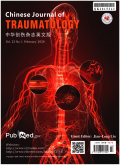- 钛学术文献服务平台 \
- 学术期刊 \
- 医药卫生期刊 \
- 外科学期刊 \
- 中华创伤杂志(英文版)期刊 \
Do clinical and paraclinical findings have the power to predict critical conditions of injured patients after traumatic injury resuscitation? Using data mining artificial intelligence
Do clinical and paraclinical findings have the power to predict critical conditions of injured patients after traumatic injury resuscitation? Using data mining artificial intelligence
基本信息来源于合作网站,原文需代理用户跳转至来源网站获取
摘要:
Purpose::The triage and initial care of injured patients and a subsequent right level of care is paramount for an overall outcome after traumatic injury. Early recognition of patients is an important case of such decision-making with risk of worse prognosis. This article is to answer if clinical and paraclinical signs can predict the critical conditions of injured patients after traumatic injury resuscitation.Methods::The study included 1107 trauma patients, 16 years and older. The patients were trauma victims of Levels I and II triage and admitted to the Rajaee (Emtiaz) Trauma Hospital, Shiraz, in 2014-2015. The cross-industry process for data mining methodology and modeling was used for assessing the best early clinical and paraclinical variables to predict the patients' prognosis. Five modeling methods including the support vector machine, K-nearest neighbor algorithms, Bagging and Adaboost, and the neural network were compared by some evaluation criteria.Results::Learning algorithms can predict the deterioration of injured patients by monitoring the Bagging and SVM models with 99% accuracy. The most-fitted variables were Glasgow Coma Scale score, base deficit, and diastolic blood pressure especially after initial resuscitation in the algorithms for overall outcome predictions.Conclusion::Data mining could help in triage, initial treatment, and further decision-making for outcome measures in trauma patients. Clinical and paraclinical variables after resuscitation could predict short-term outcomes much better than variables on arrival. With artificial intelligence modeling system, diastolic blood pressure after resuscitation has a greater association with predicting early mortality rather than systolic blood pressure after resuscitation. Artificial intelligence monitoring may have a role in trauma care and should be further investigated.

推荐文章
Using Geomechanical Method to Predict Tectonic Fractures in Low-Permeability Sandstone Reservoirs
Low-permeability sandstone reservoir
Fracture parameters
Geomechanical method
Determination of Hf-Sr-Nd isotopic ratios by MC-ICP-MS using rapid acid digestion after flux-free fu
Certified reference material
Flux-free fusion
Hf-Sr-Nd isotopic ratio
Procedural blank
Rapid acid digestion
Statistics matters in interpretations of non-traditional stable isotopic data
Isotopic data processing
Error propagation
Significant digits
Difference between means with uncertainties
内容分析
关键词云
关键词热度
相关文献总数
(/次)
(/年)
文献信息
| 篇名 | Do clinical and paraclinical findings have the power to predict critical conditions of injured patients after traumatic injury resuscitation? Using data mining artificial intelligence | ||
| 来源期刊 | 中华创伤杂志英文版 | 学科 | |
| 关键词 | Traumatic injuries Data mining Artificial Intelligence | ||
| 年,卷(期) | 2021,(1) | 所属期刊栏目 | Original Article |
| 研究方向 | 页码范围 | 48-52 | |
| 页数 | 5页 | 分类号 | |
| 字数 | 语种 | 中文 | |
| DOI | 10.1016/j.cjtee.2020.11.009 | ||
五维指标
引文网络
引文网络
二级参考文献 (54)
共引文献 (2)
参考文献 (19)
节点文献
引证文献 (0)
同被引文献 (0)
二级引证文献 (0)
1900(2)
- 参考文献(0)
- 二级参考文献(2)
1949(1)
- 参考文献(0)
- 二级参考文献(1)
1975(1)
- 参考文献(0)
- 二级参考文献(1)
1982(1)
- 参考文献(0)
- 二级参考文献(1)
1988(2)
- 参考文献(0)
- 二级参考文献(2)
1992(1)
- 参考文献(0)
- 二级参考文献(1)
1993(1)
- 参考文献(0)
- 二级参考文献(1)
1994(2)
- 参考文献(1)
- 二级参考文献(1)
1995(3)
- 参考文献(0)
- 二级参考文献(3)
1996(3)
- 参考文献(2)
- 二级参考文献(1)
1997(5)
- 参考文献(1)
- 二级参考文献(4)
1999(1)
- 参考文献(0)
- 二级参考文献(1)
2001(2)
- 参考文献(0)
- 二级参考文献(2)
2002(1)
- 参考文献(0)
- 二级参考文献(1)
2003(2)
- 参考文献(0)
- 二级参考文献(2)
2004(3)
- 参考文献(0)
- 二级参考文献(3)
2005(1)
- 参考文献(0)
- 二级参考文献(1)
2006(2)
- 参考文献(0)
- 二级参考文献(2)
2007(4)
- 参考文献(1)
- 二级参考文献(3)
2008(5)
- 参考文献(0)
- 二级参考文献(5)
2009(2)
- 参考文献(1)
- 二级参考文献(1)
2010(5)
- 参考文献(1)
- 二级参考文献(4)
2011(6)
- 参考文献(2)
- 二级参考文献(4)
2012(8)
- 参考文献(2)
- 二级参考文献(6)
2013(3)
- 参考文献(2)
- 二级参考文献(1)
2014(1)
- 参考文献(1)
- 二级参考文献(0)
2015(2)
- 参考文献(2)
- 二级参考文献(0)
2016(1)
- 参考文献(1)
- 二级参考文献(0)
2017(1)
- 参考文献(1)
- 二级参考文献(0)
2019(1)
- 参考文献(1)
- 二级参考文献(0)
2021(0)
- 参考文献(0)
- 二级参考文献(0)
- 引证文献(0)
- 二级引证文献(0)
研究主题发展历程
节点文献
Traumatic injuries
Data mining
Artificial Intelligence
研究起点
研究来源
研究分支
研究去脉
引文网络交叉学科
相关学者/机构
期刊影响力
中华创伤杂志(英文版)
主办单位:
中华医学会
出版周期:
双月刊
ISSN:
1008-1275
CN:
50-1115/R
开本:
大16开
出版地:
重庆市渝中区大坪长江支路10号
邮发代号:
78-81
创刊时间:
1998
语种:
eng
出版文献量(篇)
1765
总下载数(次)
0
总被引数(次)
7300
期刊文献
相关文献
推荐文献
- 期刊分类
- 期刊(年)
- 期刊(期)
- 期刊推荐
中华创伤杂志(英文版)2022
中华创伤杂志(英文版)2021
中华创伤杂志(英文版)2020
中华创伤杂志(英文版)2019
中华创伤杂志(英文版)2018
中华创伤杂志(英文版)2017
中华创伤杂志(英文版)2016
中华创伤杂志(英文版)2015
中华创伤杂志(英文版)2014
中华创伤杂志(英文版)2013
中华创伤杂志(英文版)2012
中华创伤杂志(英文版)2011
中华创伤杂志(英文版)2010
中华创伤杂志(英文版)2009
中华创伤杂志(英文版)2008
中华创伤杂志(英文版)2007
中华创伤杂志(英文版)2006
中华创伤杂志(英文版)2005
中华创伤杂志(英文版)2004
中华创伤杂志(英文版)2003
中华创伤杂志(英文版)2002
中华创伤杂志(英文版)2001
中华创伤杂志(英文版)2000

 免费查重
免费查重










